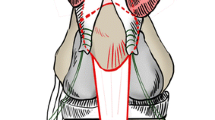Abstract
Rupture of the patellar tendon is a rare injury requiring acute repair to reestablish knee extensor continuity and to allow early motion. Different pathomechanisms have been postulated, and multiple techniques for repair have been described in the literature. Firstly, the current study reviews the epidemiology, pathomechanism, and risk factors. Secondly, we compare the outcome of two augmentation techniques after end-to-end sutures: reinforcement with either a wire cerclage or a PDS cord. In the first part of the study, the medical records of 66 patients with 68 ruptures were reviewed. For the second part, 33 patients were included who had no prior injury to the extensor mechanism of the knee and had suffered an indirect, low-velocity injury followed by immediate repair. Twenty-seven patients with 29 ruptures of the patellar tendon returned for follow-up. Follow-up averaged 8.1 years (range 1-16 years). In the follow-up group, 22 ruptures had augmentation with a wire cerclage (group A), and 7 ruptures had augmentation with a 2-mm PDS cord (group B). Follow-up evaluation consisted of a subjective questionnaire, a physical and radiographic examination, the Hospital for Special Surgery Knee Score, and the Insall-Salvati ratio. Nineteen patients underwent Cybex isokinetic strength testing of the quadriceps. Indirect, low-velocity injuries occurred most often in the 30–40 year age group, whereas complex knee traumas or knee luxations were more evenly distributed. In 10 of 46 patients with an indirect, low-velocity injury, there was a history of prior injury and illness to the extensor mechanism of the knee, compared with 1 of 22 patients with a high-velocity complex knee trauma. In the follow-up group, no patient sustained a rerupture. Two of 22 patients had an extension lag in group A compared with no extension lag in group B. Average flexion in group A was 130° (SD 29°) compared with 137° (SD 12°) in group B. The average Hospital for Special Surgery Knee Score was 92 (SD 17) in group A and 96 (SD 12) in group B. Three patients were dissatisfied. All had radiographic signs of retropatellar osteoarthritis. In contrast, 9 of 26 patients who were satisfied with their result had radiographic signs of retropatellar osteoarthritis. A postoperative difference in the Insall-Salvati ratio did not correlate with the development of osteoarthritis. Both augmentation techniques are reliable and demostrate good intermediate to long-term results. The outcome did not show significant differences. To avoid reoperation for removal of the cerclage wire, a PDS cord can be used. The infection rate seems to be higher in the PDS group. A larger prospective study group is necessary to determine whether this phenomenon can be reproduced.
Similar content being viewed by others
Author information
Authors and Affiliations
Additional information
Received: 17 January 2001
Rights and permissions
About this article
Cite this article
Kasten, P., Schewe, B., Maurer, F. et al. Rupture of the patellar tendon: a review of 68 cases and a retrospective study of 29 ruptures comparing two methods of augmentation. Arch Orth Traum Surg 121, 578–582 (2001). https://doi.org/10.1007/s004020100298
Issue Date:
DOI: https://doi.org/10.1007/s004020100298




